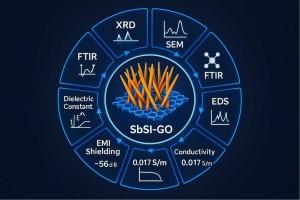Doping-Induced Structural and Electrical Modifications in SbSI Nanowires Embedded in Graphene Oxide for Enhanced Optoelectronic Applications
IF 6.3
2区 材料科学
Q2 CHEMISTRY, PHYSICAL
引用次数: 0
Abstract
The growing demand for high-performance materials in electronics and optoelectronics has intensified the focus on one-dimensional (1D) nanostructures and their composites. This work introduces a novel, in-situ method for doping antimony sulfoiodide nanowires (SbSI NWs) onto graphene oxide (GO) nanosheets, a composite approach unexplored in prior literature An innovative in-situ method was developed to fabricate these GO-SbSI composites. Comprehensive characterization via XRD and FTIR confirmed the successful formation of SbSI NWs (JCPDS no. 88-0988) and their integration with GO, evidenced by the disappearance of specific FTIR peaks (e.g., ~2900 cm⁻¹) in the composites. SEM analysis revealed a reduction in SbSI NW size to approximately 3 µm post-compositing. The electrical and dielectric properties were profoundly enhanced by the doping process. The AC conductivity of the optimal composite (H3) reached 0.017 S/m, significantly surpassing that of pure GO (0.052 S/m) and pristine SbSI (2.17×10⁻⁴ S/m). The complex dielectric behavior was analyzed, with high low-frequency permittivity attributed to various polarization mechanisms. Most notably, the composites exhibited exceptional electromagnetic interference (EMI) shielding performance. The shielding effectiveness (SER) was dramatically enhanced from -20 dB for pure GO to an outstanding -56 dB for the H3 composite, indicating a transition from a weak shielding material to a powerful attenuator of electromagnetic radiation. These results unequivocally demonstrate that the strategic doping of GO with SbSI NWs creates a superior functional material with high potential for application in advanced EMI shielding and nano-electronic devices.

掺杂诱导的SbSI纳米线在氧化石墨烯中的结构和电学修饰,用于增强光电应用
随着电子和光电子领域对高性能材料的需求不断增长,一维纳米结构及其复合材料成为人们关注的焦点。这项工作介绍了一种新的原位方法,将硫化锑纳米线(SbSI NWs)掺杂到氧化石墨烯(GO)纳米片上,这是一种先前文献未探索的复合方法。通过XRD和FTIR综合表征证实SbSI NWs (JCPDS no. 1)的成功形成。88-0988)以及它们与氧化石墨烯的结合,证明了复合材料中特定的FTIR峰(例如~2900 cm⁻¹)的消失。SEM分析显示合成后SbSI NW尺寸减小至约3µm。在掺杂过程中,材料的电学和介电性能得到了显著提高。最优复合材料(H3)的交流电导率达到0.017 S/m,明显超过纯氧化石墨烯(0.052 S/m)和原始SbSI (2.17×10⁻⁴S/m)。分析了复合介质的介电特性,发现多种极化机制导致了高低频介电常数。最值得注意的是,复合材料表现出优异的电磁干扰(EMI)屏蔽性能。屏蔽效能(SER)从纯氧化石墨烯的-20 dB显著提高到H3复合材料的-56 dB,表明从弱屏蔽材料到强电磁辐射衰减器的转变。这些结果明确地表明,在氧化石墨烯中掺杂SbSI纳米粒子创造了一种优越的功能材料,在先进的电磁干扰屏蔽和纳米电子器件中具有很高的应用潜力。
本文章由计算机程序翻译,如有差异,请以英文原文为准。
求助全文
约1分钟内获得全文
求助全文
来源期刊

Journal of Alloys and Compounds
工程技术-材料科学:综合
CiteScore
11.10
自引率
14.50%
发文量
5146
审稿时长
67 days
期刊介绍:
The Journal of Alloys and Compounds is intended to serve as an international medium for the publication of work on solid materials comprising compounds as well as alloys. Its great strength lies in the diversity of discipline which it encompasses, drawing together results from materials science, solid-state chemistry and physics.
 求助内容:
求助内容: 应助结果提醒方式:
应助结果提醒方式:


